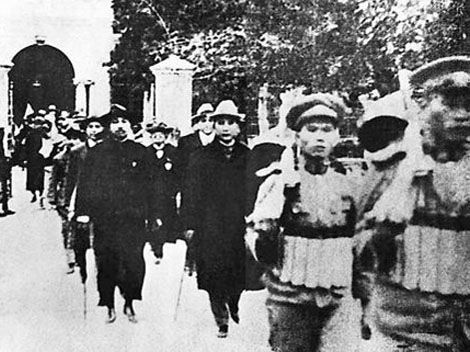 |
| First United Front |
The Bolshevik Revolution in Russia in 1917 had two major impacts on China: establishment of the Chinese Communist Party (CCP) in 1921 and reorganization of the Nationalist Party, or Kuomintang (KMT), in 1923. The result was the formation of the first (in retrospect) United Front. The Japanese invasion of China in 1937 led to the second United Front.
Sun Yat-sen, father of the Chinese Republic, and his Nationalist Party were out of power as warlords carved up China after 1913. Sun was living in Shanghai in 1919 when patriotic students rose up to demand government reforms in the May Fourth Movement. To tap into student patriotism and learn the formula of Soviet success, Sun met Soviet representative to China Adolf Joffe.
Their joint communiqué (January 23, 1923) became the basis for the first United Front. It provided for Soviet aid to reorganize the KMT, and in return Sun agreed to allow members of the CCP to join the KMT as individuals. It also declared that Sun's Three People's Principles, not Marxism, would be the ideology for China.
  |
A political change allowed Sun to form an opposition government (to the recognized one in Beijing) in Canton later in 1923. Soviet political and military advisers, headed by Michael Borodin and General Galen (Blucher), arrived in Canton.
Borodin dominated the first KMT Congress, held in Canton in 1924, where the platform mandated alliance with the Soviet Union and collaboration with the CCP that allowed CCP leaders to join the KMT's top councils. Sun sent his chief military aide, Chiang Kaishek, to Russia to study Soviet military techniques. Chiang returned home to head the new Whampoa Military Academy, which trained officers in warfare and political ideology.
The first United Front survived Sun's death in 1925 and the first phase of the successful Northern Expedition to unify China, led by Chiang. After capturing Shanghai and Nanjing (Nanking) in 1927 Chiang purged the Communists from the government and expelled the Soviet advisers, preempting Soviet leader Joseph Stalin's plans to eliminate the KMT and catapult the CCP to power. Thus ended the first United Front. Chiang went on to complete the Northern Expedition and unify China in 1928.
 |
| Second United Front |
Negotiations for a second United Front began in 1937 as a result of rising public sentiment that all Chinese civil wars should end and that the KMT should lead a united China in resisting Japanese aggression.
The movement was begun by students in 1935, picked up by the CCP, and then hard pressed by KMT forces at the end of the Long March. Japan attacked China on July 7, 1937 (the Marco Polo Bridge incident). The all-out war ensured the negotiations, which concluded in September 1937.
The agreement provided for two separate Communist armies: the Eighth Route Army of 20,000 men in northern China under commander Zhu De (Chu Teh) and the 10,000-man New Fourth Army in Jiangxi (Kiangsi) under Ye Ting (Yeh T'ing). Both units would fight under overall Nationalist command.
The CCP agreed to abolish their Soviet government, cease class struggle in areas they controlled, and obey the Nationalist central government. However, the CCP goal was to exploit the United Front for expansion, as its leader Mao Zedong (Tse-tung) announced: "Our fixed policy should be 70 percent expansion, 20 percent dealing with the Kuomintang, and 10 percent resisting Japan."
The United Front collapsed in January 1941 when the New Fourth Army disobeyed orders, and a major clash with KMT forces resulted. Negotiations between the two sides ended in 1943, and the conflict between them remained unresolved at the end of World War II.